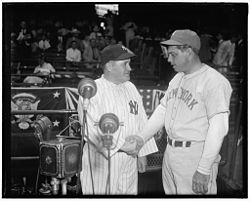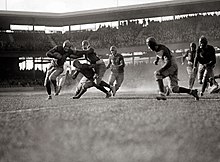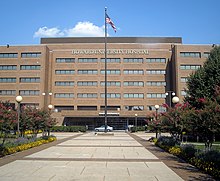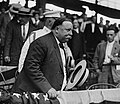Griffith Stadium
From Wikipedia, the free encyclopedia
Not to be confused with Griffiths Stadium.
| Former names | National Park (1911-1920) |
|---|---|
| Location | Washington, D.C. |
| Coordinates | 38°55′3″N 77°1′13″WCoordinates: 38°55′3″N 77°1′13″W |
| Owner | Washington Senators |
| Operator | Washington Senators |
| Capacity | 27,000 (1911-1932) 32,000 (1933-1947) 28,085 (1948) 29,731 (1949-1953) 29,023 (1954-1957) 28,669 (1958-1960) 27,550 (1961) |
| Field size | (Final) Left Field - 388 ft Left-Center - 360 ft Center Field - 421 ft Right-Center - 373 ft Right Field - 320 ft Backstop - 61 ft |
| Surface | Grass |
| Construction | |
| Opened | July 24, 1911 |
| Closed | September 21, 1961 |
| Demolished | January 26, 1965 |
| Construction cost | $100,000 |
| Architect | Osborn Engineering |
| Tenants | |
| Washington Senators (I) (MLB) (1911-1960) Washington Potomacs (ECL) (1924) Washington Pilots (EWL) (1932) Washington Elite Giants (NNL) (1936–1937) Homestead Grays (1940–1948) Washington Black Senators (NNL) (1938) Washington Senators (II) (MLB) (1961) Washington Redskins (NFL) (1937-1960) Georgetown Hoyas (NCAA) (1925-1950) George Washington Colonials (NCAA) (1930s–1940s) Maryland Terrapins (NCAA) (1948) | |
Griffith Stadium was a sports stadium that stood in Washington, D.C., from 1911 to 1965, between Georgia Avenue and 5th Street, and between W Street and Florida Avenue NW. An earlier wooden baseball park had been built on the same site in 1891. It was called Boundary Field or National Park, as its occupants were then known primarily by the nickname Nationals. This park was destroyed by a fire in March 1911 and replaced by a steel and concrete structure, also at first called National Park; it was renamed for Washington Senators owner Clark Griffith in 1920. The stadium was home to the American League Senators from 1911 through 1960, and to anexpansion team of the same name for their first season in 1961. The venue hosted the 1937 and 1956 Major League Baseball All-Star Games as well as games of the 1924, 1925, and 1933 World Series. It served as home for the Negro league Homestead Grays during the 1940s. It was also home to the Washington Redskins of theNational Football League for 24 seasons, from the time they transferred from Boston in 1937 through the 1960 season.
In 1911 William Howard Taft began the tradition of presidents throwing out the ceremonial first pitch of the baseball season at Griffith Stadium.
In 1965 the park was demolished. The Howard University Hospital now occupies the site.
Contents
[hide]Early history[edit]
On March 17, 1911, Boundary Field, also known as National Park and American League Park II, was destroyed by a fire started by a plumber's blowtorch.[1][2] This left the owners of the Washington Senators in a difficult situation, due to the fact that spring training had already begun and opening day was less than a month away. Thomas C. Noyes, president of the Senators, gained approval from the club's board of directors to build a new ballpark with a steel grandstand on the same site as Boundary Field. The quick construction of the ballpark was reported by The Washington Post: "Day and night the chanting of the negro laborers has been heard in the vicinity, like Aladdin's palace, the structure rose as if by magic."[2] Opening Day 1911, the grandstand was sufficiently stable to host President William Howard Taft and the Boston Red Sox, as well as 16,000 fans.[3] Construction of Griffith Stadium continued while the Senators were on the road, and was not completed until July 24, 1911.[4]
Field design[edit]
The stadium was laid out at an angle within its block in the Washington street grid. Thus it was over 400 feet down the left field line (east) to the bleachers (though this distance was shortened in later years by the construction of an inner fence). The fence also took an unusual right-angled jut into right-center field where a large tree and several apartment buildings stood, due to the unwillingness of the owners of the tree and those nearby houses to sell to the Senators' owners during construction of the stadium. The right-field fence angled away from the infield sharply, which, in addition to a 30-foot fence (to block the view from surrounding buildings) about 8 feet inside the lower, outer wall, meant that relatively few home runs were hit at the stadium. Center field was east-southeast of home plate, which made for difficult visibility for the fielders in the late afternoon sun. Senators groundskeepers maintained a downhill slope from home plate to first base, supposedly to help accelerate slow Washington batters. However, Griffith's groundskeepers were still adept at keeping a fine sod field that was "compared to that of the best golf courses". This was in sharp contrast to the unkempt field that can be seen in photographs of Griffith prior to 1923.[5] For many years, the right field grandstand wall served as the right-field foul line for the last 15 feet before the foul pole, making it impossible to catch a ball there.[1] The 41-foot tall, hand-operated scoreboard in right-center was in play, as was the National Bohemian beer sign, shaped like a bottle, 56 feet above the playing field.[6] At one point in his youth, future MLB Commissioner Bowie Kuhn was the operator of the scoreboard.[2]
Expansion and changes[edit]
In the early 1920s, a trend began of fans flocking in great numbers to the stadium to see baseball's rising stars from opposing teams; when the New York Yankees came to Washington, the chance to see Babe Ruth brought large crowds to the ballpark.[5]Clark Griffith took advantage of this trend by making small improvements in the stadium in 1920 and 1921. These improvements included changing the main entrance of the park from Georgia Avenue to a refurbished one on Florida Ave., and spending $3,200 to build an office for himself beneath the grandstand.[5] After various other small improvements, on August 21, 1923, Griffith announced plans to greatly expand and refurbish the ballpark.[5] The stadium, built in 1911, was hastily constructed and provided minimal seating and other features when compared with other ballparks. The planned expansion was reported to cost $100,000, and expand the seating capacity to 50,000, a number that wound up being 32,000.[7] The new seating came from the complete rebuilding of the left-field grandstand into a double-decked tier. The new upper section was wider than the old, resulting in a roofline that was considerably higher than the roof of the main grandstand, leaving a visible 15-foot gap between the two.[5][8] At that point the wooden left-field bleachers were also replaced, by a large concrete deck that ran from the foul pole across left field and into center field. The first-base pavilion remained single-decked. The first attempt at a high wall was constructed across right field.
By the 1930s the right field pavilion had been double-decked, and the angling right field wall and its scoreboard were reconstructed to align with the low right field wall, about 8 feet inside of it. This also resulted in the unique inward-pointing 90-degree angle in center field. Both versions of the tall fence had the effect of keeping the neighbors in the adjacent row houses from watching the games for free.
Lights were installed for the 1941 season. The Senators played their first home night game on May 28.[9]
The right-field fence was originally covered in various billboard advertisements, but in later years was painted a solid dark color. A bullpen area was built in right center field behind a short fence, providing a new target for left-handed batters. In the mid-1950s, an inner fence was erected across left and center field, to reduce the home run distances by 10 to 20 feet. This inner fence stayed in place through the ballpark's final season, 1961.
A presidential destination[edit]
 | |
Every president of the United States from William Howard Taft to John F. Kennedy threw a ceremonial first pitch at least once at Griffith. The Senators even constructed a special presidential box near the first-base dugout for the annual ritual.[11]
Franklin D. Roosevelt was a good friend of Clark Griffith, and had attended games at the stadium since his days as Assistant Secretary of the Navy in the 1910s. When FDR returned to Washington in 1933 as president, Griffith visited the White House early every season to give Roosevelt season passes; he also constructed a special ramp at the ballpark that accommodated the president's special mobility needs after his bout with polio in 1921.[2] On Opening Day in 1941, Roosevelt stood up in the stadium's presidential box on the arm of a military aide, and threw out the first pitch.[2] In 1942 Clark Griffith urged Roosevelt to keep baseball going during the war. Griffith took credit after Roosevelt's initial "Green Light letter," which allowed baseball to continue.[2]
Notable sluggers[edit]
The distant fences were no problem for sluggers like Josh Gibson, Mickey Mantle, and the Senators' own youngster Harmon Killebrew. There have been only three reported instances of a player hitting a home run over the left field bleachers: once by Mantle and twice by Gibson.[12] Babe Ruth hit near-500-foot drives over the center and right-center walls on consecutive days in May 1921.
In May 1949, Cleveland Indians outfielder Larry Doby smacked the then-longest home run ever hit at the stadium over the right-center field wall, and onto a rooftop well outside the ballpark. The shot was reported to have traveled over 500 feet, and Doby called it "the longest homer I've ever hit".[13]
On April 17, 1953, Mantle hit one off Chuck Stobbs that was so impressive that someone tried to determine its flight with some precision, thus popularizing the term "Tape Measure Home Run". It was alleged to be 565 feet, although it bounced off the top of the back wall of the bleachers, adding some distance to its flight path.[14]
Clark Griffith once said that Josh Gibson hit more home runs into Griffith Stadium's distant left-field bleachers than the entire American League.[1] Aside from some championship seasons in the early 1920s and 1930s, the Senators teams that played at Griffith Stadium were legendarily bad. The hapless Washington team became the butt of a well-known Vaudeville joke, "First in war, first in peace, and last in the American League," a twist on the famous Henry "Light Horse Harry" Lee eulogy of George Washington: "First in war, first in peace, and first in the hearts of his countrymen." (A similar phrasing was once used for the St. Louis Browns: "First in shoes, first inbooze, and last in the American League.")
Only one Washington, D.C., public high school baseball player ever hit a home run over the 30-foot-high "green monster–like" right field wall at Griffith Stadium—Bill Harrison of Coolidge High School in 1952.
The stadium was still called Griffith Stadium in 1961, even though team owner Calvin Griffith had moved the original Senators club to the Twin Cities area of Minneapolis-St. Paul (becoming the Minnesota Twins), to be replaced in Washington by a new expansion team, also called the Senators (now the Texas Rangers).
Football[edit]
Griffith Stadium hosted numerous football events before the Redskins moved there in 1937.[5] It was the home of Georgetown Hoyas football from 1921 until 1950, George Washington Colonials football in the 1930s and 1940s, and Maryland Terrapins football in 1948.[12] The stadium was the host of an annual Thanksgiving Day game between Howard and Lincoln Universities, which was one of the most popular events during the year, drawing many African American alumni and fans from the surrounding neighborhoods.[5][15] One major reason for the stadium's early-1920s expansion was that Clark Griffith had envisioned the stadium hosting the annual Army–Marine football game, played every December.[5] Temporary seats were often placed in right field for football games at Griffith, with the gridiron stretching from left field to the first base line. The exceptional distance from home to the left-field area allowed plenty of room for the football field.
Washington Redskins[edit]
The Redskins, previously based in Boston and named for the Boston Braves, moved their home to D.C. in time for the 1937 NFL season. As Boston, they had won their division in 1936 and would continue their winning ways in Washington, capturing their first NFL championship in that 1937 season. They would continue being perennial contenders all through the war years.
Griffith Stadium was the location of 1940 and 1942 NFL Championship Games. The 1940 game was the 73–0 triumph by the Chicago Bears over the Redskins, the highest-scoring shutout game in the history of the NFL. The Championship Game in 1942 was essentially a rematch, with nearly the same players, and this time the Redskins upset the previously undefeated Bears, 14–6. According to Richard Whittingham's history of the Chicago Bears (ISBN 0671628852), George Preston Marshall, the owner of the Redskins, gave his team a pre-game pep talk that consisted simply of writing "73–0" on the chalkboard.
During the Redskins' game on the afternoon of December 7, 1941, against the Philadelphia Eagles, an announcement was made over Griffith Stadium's public-address system commanding all of the American generals and admirals there to report to their duty stations. The Japanese attack on Pearl Harbor was not explicitly announced over the P.A. system; with no small, portable radios available in the 1940s, that left thousands of other spectators to be among the last Americans to learn of the Japanese attack. The Redskins won that game, their last game of the 1941 season, by a score of 20 to 14. They finished the season with a record of six wins and five losses, in third place in the NFL Eastern Division. Although the Redskins enjoyed only one winning record at home (4–2 in 1956) during their final 13 seasons at Griffith, they still finished with an 81-58-6 overall record at the stadium over 24 seasons.[16]
Other events[edit]
Griffith Stadium was home to many events other than baseball and football. The All-American Girls Professional Baseball League played games there during the league's existence.[17] Over 180 boxing matches were held at the ballpark, including fights by Joe Louis.[18] On July 23, 1942, a "battle of music" was held at Griffith between musicians Louis Armstrong and Charlie Barnet. Some of the 18,000 fans in attendance began to dance on the field in front of the bandstand. Spectators who remained in their seats complained that they could not see. When the police attempted to control the situation by stopping the music, a riot broke out, with some minor injuries and several teenagers being hauled away by the police.[19]
Scrap metal salvage rallies were held at least once at the stadium during World War II, where people would bring scrap metal to the ballpark to be melted and made into steel for new weapons.[20] Griffith was also the home to public school events, church revivals, public meetings, and annual ROTC drill competitions.[5][21] Billy Graham held a crusade at Griffith in 1960, preaching from a platform erected near second base. Two choir stands, each accommodating 500 singers, were set up along the foul lines.[22]
Status in racial disputes[edit]
Griffith Stadium was located in the Ledroit Park Neighborhood, of Washington, D.C., a historically black area since the Civil War. The neighborhood was home to many black working-class people, but also a class of young professional African American "elite" including Langston Hughes. Duke Ellington worked at Griffith selling hot dogs during his childhood.[5]
Griffith Stadium was not officially segregated, although an unofficial policy early after the 1920s expansion was that blacks sat in the right field pavilion. Calvin Griffith, nephew of Clark Griffith, claimed that the segregated seats were a result of "colored preachers ... asking Mr. Griffith to put aside a section for the black people."[5]
Shortly after the end of World War I, after a report that several white women had been raped by a black man, a large group of whites seeking revenge marched toward the Shaw neighborhood. However, a conflict was avoided after these men came upon "a group of two thousand armed black men," who had been prepared and gotten their weapons at Griffith Stadium, chosen as a meeting place because of its landmark status in the community.[5]
Senators management, seemingly uneasy about racial matters, were latecomers to integrating their team, hiring their first black player in late summer of 1954. The segregationist policy of the Redskins was more overt and controversial. In October 1957, a group of blacks picketed multiple times in front of Griffith Stadium, protesting the lack of black players on the Redskins.[23] It would be five more years before the Redskins finally began employing black players, the last NFL team to erase the color line.
Final years[edit]
In 1955, longtime Senators owner Clark Griffith died. His nephew, Calvin Griffith, took over. Fewer and fewer fans were coming to the ballpark, due in large part to the St. Louis Browns' move to Baltimore in 1954, causing Baltimoreans to stop having to come to Washington to see games.[12] Because of this, Calvin Griffith developed an interest in moving the Senators to Minnesota. Attendance may not have been the sole reason Griffith wanted to move, however; in a speech to Minnesota businessmen in the 1970s, Griffith said, "You only have 15,000 blacks here".[24] The American League opposed a move at first, but agreed under the condition that an expansion team, also named the Senators, would come to Washington, beginning in 1961.[25] The original Senators moved to Minnesota, and the new Senators played at Griffith in 1961. However, in 1962, the Senators moved to the new D.C. Stadium, joining the Redskins, who had moved there a year before. The final baseball game at Griffith Stadium was played on September 21, 1961, before a crowd of only 1,498 fans.[26] Griffith Stadium now had no tenants, and sat empty for several years, deteriorating, with the field taking on the appearance of a prairie. The ballpark was demolished in 1965. Nearly a thousand of the stadium's seats were moved to Tinker Field in Orlando, Florida, at that time the spring training home of the Senators/Twins, where they remain today.[4] The Howard University Hospital now occupies the site. A plaque has been erected in the building, near home plate.[27]


















No comments:
Post a Comment